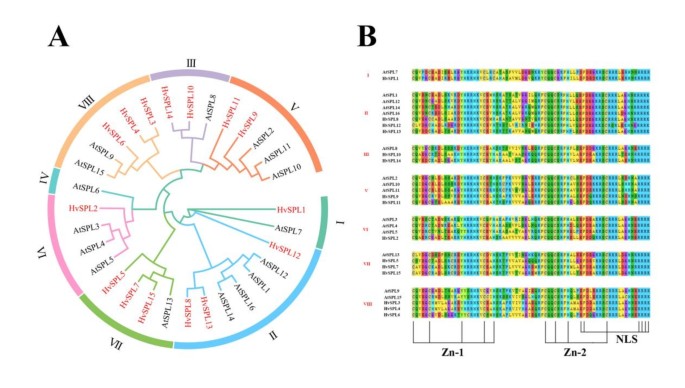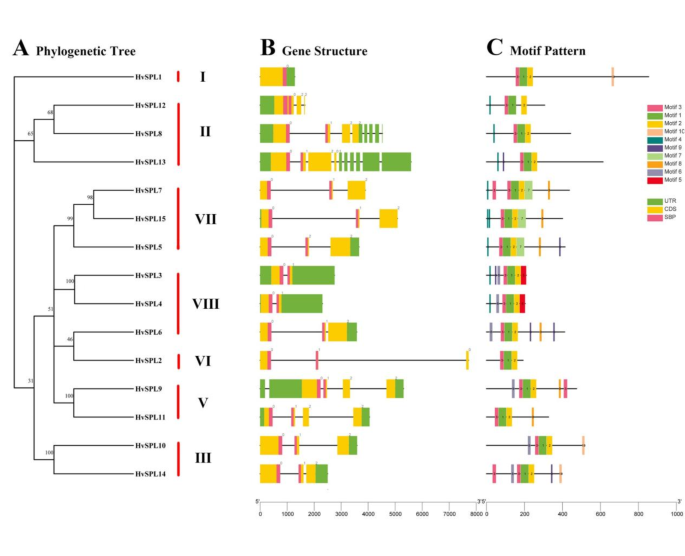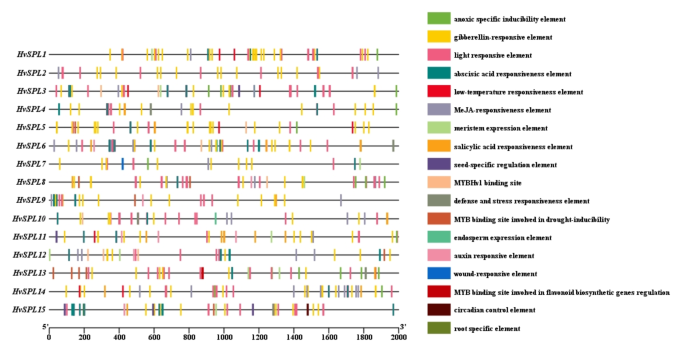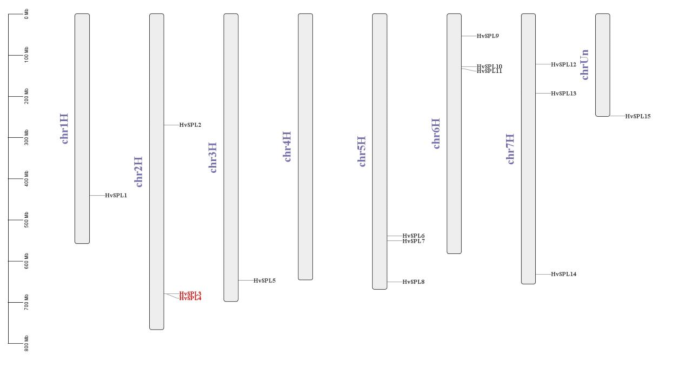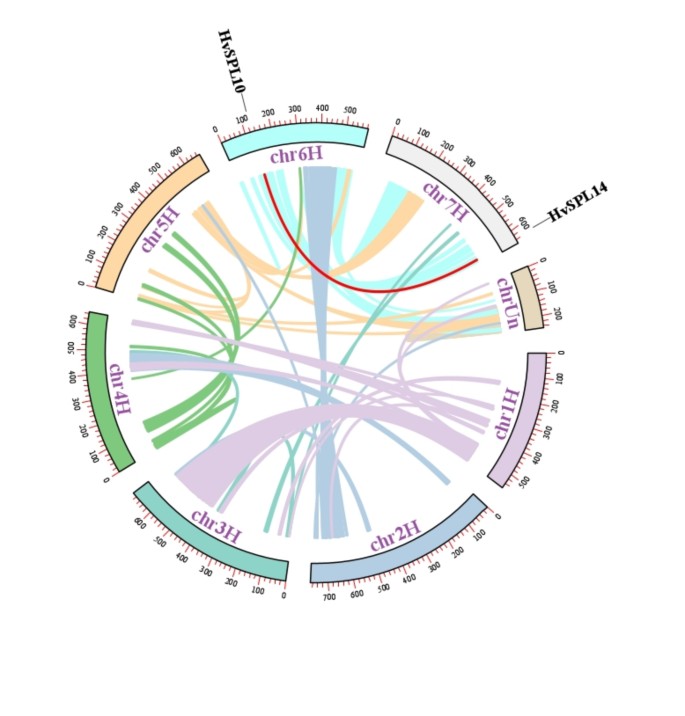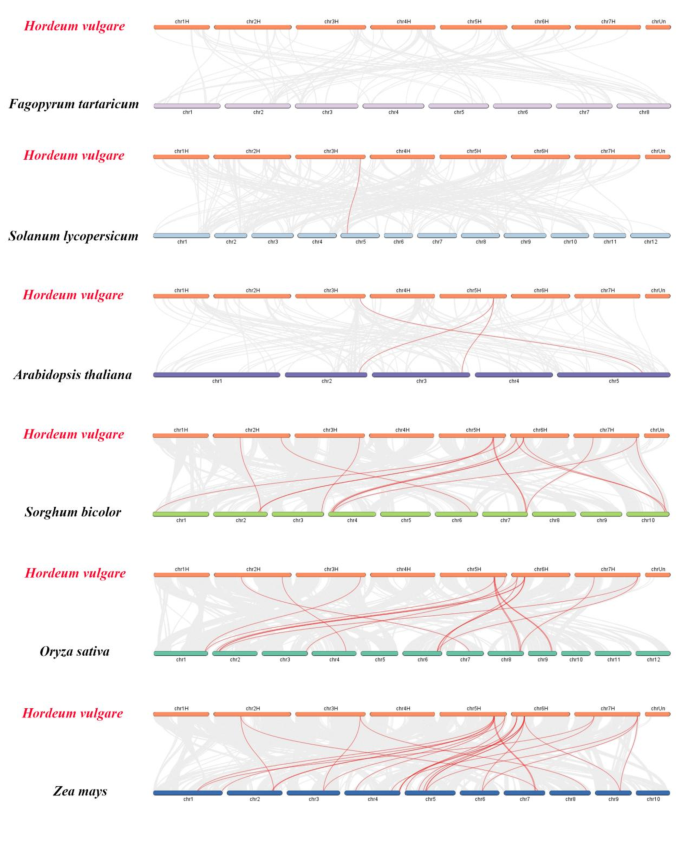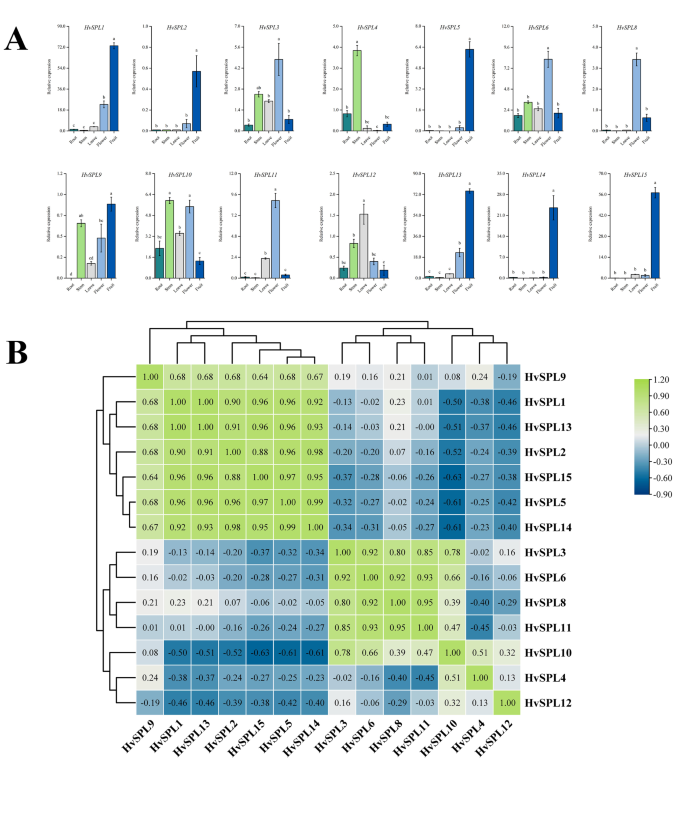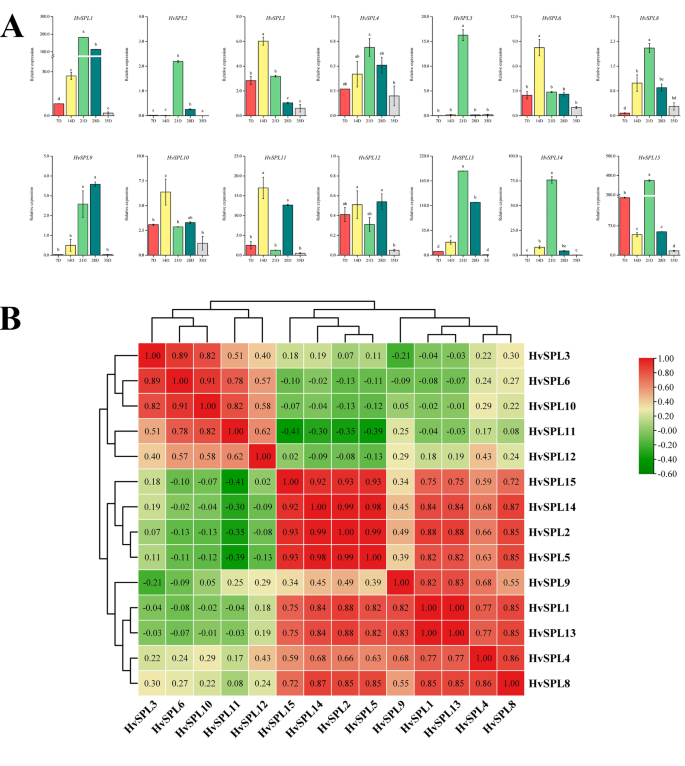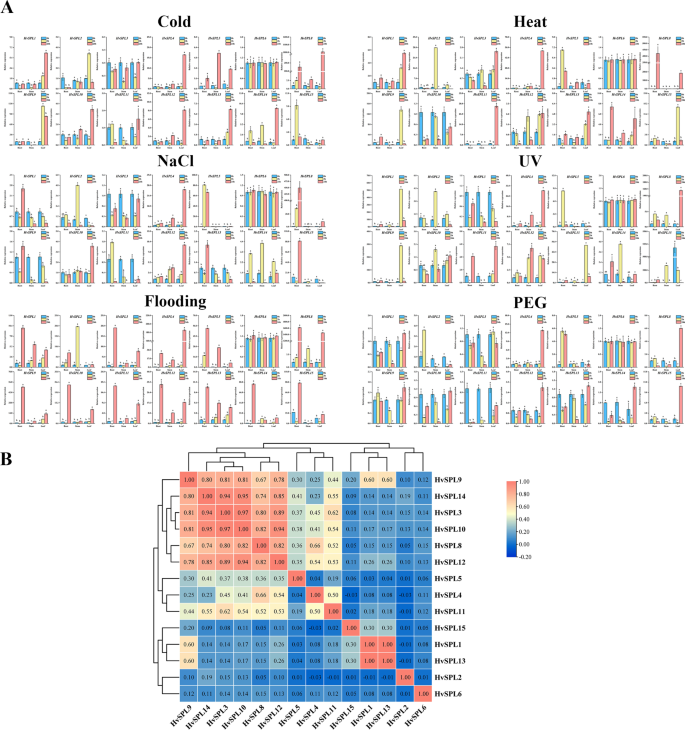- Research
- Open access
- Published:
Genome-wide identification and expression analysis of the SPL gene family and its response to abiotic stress in barley (Hordeum vulgare L.)
BMC Genomics volume 25, Article number: 846 (2024)
Abstract
Background
Squamosa promoter-binding protein-like (SPL) is a plant-specific transcription factor that is widely involved in the regulation of plant growth and development, including flower and grain development, stress responses, and secondary metabolite synthesis. However, this gene family has not been comprehensively evaluated in barley, the most adaptable cereal crop with a high nutritional value.
Results
In this study, a total of 15 HvSPL genes were identified based on the Hordeum vulgare genome. These genes were named HvSPL1 to HvSPL15 based on the chromosomal distribution of the HvSPL genes and were divided into seven groups (I, II, III, V, VI, VII, and VIII) based on the phylogenetic tree analysis. Chromosomal localization revealed one pair of tandem duplicated genes and one pair of segmental duplicated genes. The HvSPL genes exhibited the highest collinearity with the monocotyledonous plant, Zea mays (27 pairs), followed by Oryza sativa (18 pairs), Sorghum bicolor (16 pairs), and Arabidopsis thaliana (3 pairs), and the fewest homologous genes with Solanum lycopersicum (1 pair). The distribution of the HvSPL genes in the evolutionary tree was relatively scattered, and HvSPL proteins tended to cluster with SPL proteins from Z. mays and O. sativa, indicating a close relationship between HvSPL and SPL proteins from monocotyledonous plants. Finally, the spatial and temporal expression patterns of the 14 HvSPL genes from different subfamilies were determined using quantitative real-time polymerase chain reaction (qRT-PCR). Based on the results, the HvSPL gene family exhibited tissue-specific expression and played a regulatory role in grain development and abiotic stress. HvSPL genes are highly expressed in various tissues during seed development. The expression levels of HvSPL genes under the six abiotic stress conditions indicated that many genes responded to stress, especially HvSPL8, which exhibited high expression under multiple stress conditions, thereby warranting further attention.
Conclusion
In this study, 15 SPL gene family members were identified in the genome of Hordeum vulgare, and the phylogenetic relationships, gene structure, replication events, gene expression, and potential roles of these genes in millet development were studied. Our findings lay the foundation for exploring the HvSPL genes and performing molecular breeding of barley.
Background
Transcription factors exist in all organisms and are the key molecules involved in regulating gene expression. The SQUAMOSA PROMOTER-BINDING PROTEIN-Like (SPL) is a plant-specific transcription factor family [1]. SPL genes were first discovered in Antirrhinum majus and later found to be conserved in plants, such as Arabidopsis thaliana [2], Oryza sativa [3], Zea mays [4], Triticum aestivum [5], Salvia miltiorrhiza [6], Capsicum annuum [7], etc. SPL has a highly conserved SBP domain, and most SPL family genes contain a highly conserved DNA-binding domain consisting of approximately 76 amino acids, two zinc-binding sites (Cys-Cys-Cys-His and Cys-Cys-His-Cys), and a nuclear localization signal (NLS) involved in DNA binding that overlaps with the second Zn finger at the C-terminus of the SBP domain [8]. The number of SPL genes varies among species. For example, Arabidopsis thaliana has 16 SPL genes [2], Oryza sativa has 19 SPL genes [3], Solanum lycopersicum has 15 SPL genes [9], Fagopyrum tataricum has 24 SPL genes [10], Setaria italica has 18 SPL genes [11], and Zea mays [4] and Populus L [12]. have 31 and 28 SPL genes, respectively. In previous studies, the SPL gene family was divided into eight groups based on the conserved SBP domain. Plant gene families have become increasingly accessible due to increased genome sequencing for numerous species. Many gene families in barley have been fully identified and analyzed, including bHLH [13], NAC [14], GRAS [15], AP2/ERF [16], HSP20 [17], OSCA [18], PP2C [19], HMA [20], etc.
SPL genes play important roles in various aspects of plant growth and development, including the regulation of floral organ development, control of the transition from vegetative to reproductive growth, leaf development, grain ripening, plant hormone and light signal transduction, and response to stress [21,22,23,24,25,26,27,28]. In Arabidopsis, AtSPL2, AtSPL9, AtSPL10, AtSPL11, AtSPL13, and AtSPL15 play important roles in plant development and vegetative-to-reproductive transition [24]; AtSPL10 partially regulates bud development during the vegetative phase [29]; AtSPL8 influences gibberellin (GA)-mediated pollen sac development and maturation [30]; AtSPL14 regulates normal plant structure development and plant response to fumonisin B1 toxin [31]; and AtSPL1 and AtSPL12 redundantly function in heat tolerance during the reproductive stage [32].
Barley (Hordeum vulgare L.) is the world’s fourth largest cereal crop, after rice, maize, and wheat, and is widely cultivated for malt production, brewing, and feed production. Barley is known for its good resistance to abiotic stress and is grown extensively worldwide. Barley grains are rich in unique components, such as polyphenols, flavonoids, and β-glucans, and have low-fat and antioxidant properties, resulting in their extensive use in the development of health products [33]. The SPL gene family plays important regulatory roles in plant growth and development, grain ripening, abiotic and biotic stress responses, and the maintenance of copper homeostasis in plants. However, a comprehensive study of the SPL gene family in barley has not been conducted. In this study, we aimed to carry out a comprehensive analysis of the gene structure, motif composition, cis-acting elements, chromosomal location, and duplications of SPL genes in the barley genome. We also compared the evolutionary relationships between barley and A. thaliana, F. tataricum, S. lycopersicum, O. sativa, S. bicolor, and Z. mays. Grouping analysis of the HvSPL genes with that of other plants was performed, including phylogenetic tree, motif composition, and evolutionary relationships between HvSPL genes and the three monocotyledonous and three dicotyledonous plants. We also examined tissue-specific expression, expression during the five stages after flowering, and the expression patterns under six abiotic stresses of the 14 HvSPL genes identified in this study. This study not only provides a theoretical basis for screening the SPL genes involved in barley growth and development and their response to adversity but also lays the foundation for exploring and using these functional genes.
Results
Identification of the HvSPL genes
In the present study, two BLAST methods were used to identify all potential SPL members in the barley genome. After removing redundant genes, 15 HvSPL genes were identified and named HvSPL1-HvSPL15 based on their chromosomal positions (Table S1). The basic characteristics of these genes, such as protein length, molecular weight (MW), isoelectric point (pI), domain information, and subcellular localization, were investigated (Table S1). Among the 15 HvSPL proteins, HvSPL2 had the shortest amino acid sequence length of 192, whereas HvSPL1 had the longest sequence length of 853. The relative molecular weights (MW) of these proteins ranged from 20.12 kDa (HvSPL2) to 93.30 kDa (HvSPL1). The isoelectric points (pI) of these proteins ranged from 5.69 (HvSPL1) to 9.87 (HvSPL2), with a mean value of 8.47. Most pI values were greater than 7, indicating that this gene family is biased toward basic amino acids. Based on the subcellular localization prediction results for the 15 HvSPL proteins, all were localized to the nucleus.
Phylogenetic analysis, classification, and multiple sequence alignment of the HvSPL proteins
Based on the identified amino acid sequences of 15 H. vulgaret and 16 A. thaliana SPL proteins, a phylogenetic tree was constructed using TBtools software with a bootstrap setting of 1,000 (Fig. 1A). According to the reported classification method for Arabidopsis, these 31 SPL proteins were found to cluster into eight subfamilies (I–VIII), with no HvSPL members in subfamily IV. Consequently, the HvSPL gene family was divided into seven subfamilies. Subfamilies I and VI had only one barley member each, whereas subfamilies III and V had two barley members each. Subfamilies II, VII, and VIII contained three barley members each. Based on the position of the SBP domain, we extracted the SBP domain sequences (approximately 76 amino acids) of the AtSPL and HvSPL proteins for multiple sequence alignment. As shown in Fig. 1B, the barley SBP domain was generally conserved at specific positions, such as in the CQQC, SCR, and RRR sequences. Almost all HvSPL protein sequences contained two zinc finger-like structures, Zn-1 and Zn-2, and a highly conserved nuclear localization signal (NLS). In subfamily I, the Zn-1 (Cys-Cys-Cys-His) sequence underwent a certain mutation, with the fourth amino acid being mutated to cysteine. This mutation may indicate a conformational change in the zinc-finger binding site 1 of subfamily I, conferring it with unique functionality. However, this phenomenon was not observed in other subfamilies containing the highly conserved Zn-1 (Cys-Cys-Cys-His) and Zn-2 (Cys-Cys-His-Cys) sequences.
Gene structures, motif composition, and cis‑acting elements analysis of the HvSPL gene family
To further understand the structural composition of barley SPL genes, we compared the number and positions of exons and introns in barley SPL gene sequences (Fig. 2A). Ten conserved motifs (Motif 1–10) were detected in the HvSPL genes. By analyzing the intron-exon structure of the barley SPL genes, we explored the evolutionary process of the barley SPL gene family. As shown in Fig. 2B, the intron-exon structures of the same subfamily were similar but significantly different among different subfamilies. For example, subfamily II (HvSPL8, HvSPL12, and HvSPL13) had the highest number of introns, with an average of six. The other subfamilies had fewer introns, with an average of 1.9. The subfamily with the fewest introns was subfamily I. Notably, HvSPL1 had no introns.
To understand the differences in conserved motifs among barley SPL proteins, we used the online MEME website to detect the motif composition of 15 HvSPL gene sequences, including sequences of the SBP domain. Ten different conserved motifs, namely motifs 1–10, were identified in these sequences (Fig. 2C, Table S2). Motifs 1, 2, and 3 were present in all HvSPL members, whereas motif 7 was unique to subfamily VII (HvSPL5, HvSPL7, and HvSPL15). Other subfamilies did not contain this motif. In addition, subfamily VIII (HvSPL3 and HvSPL4) contained a special motif, motif 5. In summary, the arrangement of motifs in the same subfamily was similar, indicating the relative conservation of these protein structures and their tendency to cluster together in the phylogenetic tree. This result is consistent with that of the phylogenetic analysis and supports the reliability of the HvSPL subfamily classification.
In this study, the promoter sequences upstream of the start codons (ATG) of the 15 HvSPL genes were obtained from the barley genome sequence, and a visualization diagram of cis-acting elements was created using the TBtools software (Fig. 3). Analysis of the promoter sequences of the 15 HvSPL genes revealed that cis-acting elements in the promoter region could be classified into four main categories: light-responsive elements, stress-responsive elements, hormone-responsive elements, and growth and development-responsive elements. Among these, GA responsiveness and light responsiveness had the highest numbers, with 159 and 154 elements, respectively, and were widely distributed across various promoter sequences. Among the hormone-related response elements, all genes were GA-responsive elements; most HvSPL genes contained abscisic acid responsiveness elements and MeJA-responsiveness elements, and few genes contained auxin-responsive elements and salicylic acid-responsive elements. Among these, the promoter of HvSPL14 contained the highest number of hormone-responsive elements [34]. Among the environmental stress-related elements, HvSPL5 contained low-temperature responsiveness elements, anoxic-specific inducibility elements, and MYB binding sites involved in drought inducibility; HvSPL13 contained defense and stress responsiveness elements, anoxic-specific inducibility elements, and MYB binding sites involved in drought inducibility. In addition, the promoters of HvSPL6 and HvSPL10 contained one endosperm expression element, indicating that these two genes may directly or indirectly regulate barley endosperm development.
Phylogenetic relationship, gene-structure analysis, and motif distributions of H. vulgare SPL genes. (A) The phylogenetic tree was constructed with 1,000 replicates on each node. (A) Green rectangles and black lines indicate exons and introns, and the domains are color-coded. (C) Amino acid motifs in H. vulgare SPL (1–10) are represented by colored boxes. The black lines indicate relative protein lengths
Chromosomal distribution, gene duplication, and synteny analysis of the HvSPL genes
Based on the latest Hordeum vulgare genome database, a chromosome map was constructed and 15 HvSPL genes were randomly distributed on eight barley chromosomes (Fig. 4). Each HvSPL gene was named from top to bottom based on its physical position on the barley chromosome (Chr), 1 H to Un. No HvSPL genes were detected on Chr4H. This absence may be due to fragment loss or chromosomal translocation during evolution. Chr2H, 5 H, 6 H, and 7 H contained three HvSPL genes, whereas Chr1H, Chr3H, and ChrUn contained 1 HvSPL gene each. Gene duplication events are crucial for the evolution of gene families and play important roles in gene amplification and the generation of new functional genes. When two or more identical genomic regions are found within a 200 kb chromosome region, a tandem duplication event occurs [35]. Therefore, we investigated the duplication events of the HvSPL genes in the barley genome and found one tandem duplication event involving two HvSPL genes on Chr2H (Fig. 4, Table S3). These two tandem duplicated genes belong to the same subfamily (IV). Using the BLASTP and MCScanX methods, we identified a segmental duplication event involving a pair of genes distributed on chromosomes 6 H and 7 H in the HvSPL gene family (Fig. 5, Table S4). This pair of segmental duplicated genes belonged to the same subfamily (III).
To further study the phylogenetic mechanisms of the barley SPL family, we constructed six collinearity maps between barley and three dicotyledonous plants (A. thaliana, F. tataricum, S. lycopersicum) and three monocotyledonous plants (O. sativa, S. bicolor, Z. mays). Based on the results, the HvSPL genes had the highest number of homologous genes with the monocotyledonous plant, Z. mays (27 pairs), followed by O. sativa (18 pairs), S. bicolor (16 pairs), and A. thaliana (three pairs), and the fewest homologous genes with S. lycopersicum (one pair). However, none of the genes were homologous to those in F. tataricum. The collinearity between the HvSPL gene family and monocotyledonous plants was stronger than that between this gene family and dicotyledonous plants. HvSPL5 had homologous genes in all five species (Table S5). Except for F. tataricum and S. lycopersicum, HvSPL6 had homologous genes in the other four plants. This result suggests that HvSPL5 and HvSPL6 may have existed before the differentiation of monocotyledonous and dicotyledonous plants and continue to play important roles in these species. Overall, barley SPL genes had the highest homology with those in Z. mays, indicating that these highly homologous genes evolved from a common ancestor of different plants.
Schematic of the chromosomal distribution of SPL genes in Hordeum vulgare. The gray vertical bars represent the chromosomes of H. vulgare. The chromosome number is indicated to the left of each chromosome. The scale on the left represents chromosome length. The red font represents the tandem gene duplication
Synteny analysis of the SPL genes between Hordeum vulgare and six representative plants (Fagopyrum tataricum, Solanum lycopersicum, Arabidopsis thaliana, Sorghum bicolor, Oryza sativa, Zea mays). The gray lines between Hordeum vulgare and other plants indicate collinearity in the wide genome of Hordeum vulgare and other plants, while the red lines highlight the collinear SPL gene pairs
Evolutionary analysis of the HvSPL proteins in barley and the HvSPL proteins in different plants
To investigate the evolutionary relationships of SPL genes, we analyzed the phylogenetic trees of the identified HvSPL genes in three dicotyledonous plants (A. thaliana, F. tataricum, S. lycopersicum) and three monocotyledonous plants (O. sativa, S. bicolor, Z. mays). Phylogenetic trees were constructed based on the sequences of 138 SPL proteins via the MEME network server, which revealed the presence of 10 conserved motifs (Fig. 7, Table S2). As shown in Fig. 7, the distribution of HvSPL in the evolutionary tree was relatively scattered, with HvSPL proteins clustering with SPL proteins from Z. mays and O. sativa, indicating a close phylogenetic relationship between HvSPL and monocotyledonous SPL. Furthermore, motifs 3, 2, 1, and 6 were conserved and alternately distributed among all subfamilies. This result suggests that motif composition is crucial for SPL genes and may have important implications for the protein function of SPLs. Similar motifs tended to be distributed in specific subfamilies of SPL. For example, motifs 10, 5, and 8 tended to cluster within subfamily II, indicating that SPL genes within the same subfamily have similar motif compositions, which suggest similar structures and functions. However, significant differences were found among different subfamilies. Subfamily II contained motif 5, whereas the other subfamilies did not contain this motif. Subfamilies V and VIII contained the unique motifs 7 and 9 but lacked motif 4. Subfamily VI exhibited the greatest difference, comprising motifs 3, 2, 1, and 6 but lacking other conserved motifs.
Phylogenetic relationship and conserved motifs of the SPL protein in Hordeum vulgare and six plants (Fagopyrum tataricum, Solanum lycopersicum, Arabidopsis thaliana, Sorghum bicolor, Oryza sativa, Zea mays). The outer part of the circle represents the phylogenetic tree of SPL proteins, and the inner part of the circle represents different conserved motifs and protein lengths. Boxes of different colors represent different motifs and their positions in each SPL protein sequence
Expression patterns of HvSPLs in different plant tissues
To investigate the physiological functions of HvSPL genes, we performed qRT-PCR to determine the relative expression levels of 14 HvSPL genes in different tissues (roots, stems, leaves, flowers, and grains) (Fig. 8A). Different genes were found to exhibit distinct expression patterns in different tissues. Certain genes are preferentially expressed in specific barley tissues. Among these, two genes (HvSPL4 and HvSPL10) showed the highest expression levels in stems, while HvSPL12 was highly expressed in leaves. Four genes (HvSPL3, HvSPL6, HvSPL8, and HvSPL11) had the highest expression levels in flowers, whereas seven genes (HvSPL1, HvSPL2, HvSPL5, HvSPL9, HvSPL13, HvSPL14 and HvSPL15) had the highest expression levels in grains. Most genes exhibited relatively low expression in the roots. Furthermore, the correlation between HvSPL expression in the five organs was investigated (Fig. 8B). The expression of different genes in the plant organs was found to be positively correlated, suggesting their potential synergistic roles. The most significant positive correlation was observed between pairs of genes, such as HvSPL3, HvSPL6, HvSPL8, and HvSPL11, which were highly expressed in the flower and showed a significant positive correlation (P < 0.05). HvSPL4, HvSPL10, and HvSPL12 were negatively correlated (P < 0.05) with HvSPL1, HvSPL2, HvSPL5, HvSPL13, HvSPL14, and HvSPL15, all of which were highly expressed in grain.
Tissue-specific expression of 14 H. vulgare SPL genes and the correlation with the expression patterns of HvSPLs. (A) The expression patterns of 14 barley SPL genes in the root, stem, leaf, flower, and grain tissues were examined using qPCR. Error bars are based on three measurements. Lowercase letter(s) above the bars indicate significant differences (α = 0.05, LSD) among the treatments. (B) Positive number: positively correlated; negative number: negatively correlated. The red numbers indicate a significant correlation at 0.05
Expression patterns of the HvSPL genes in barley during grain development
Some HvSPLs may regulate barley grain development, thereby affecting the nutrient content and development rate. To identify the genes that may regulate barley grain development, the expression of 14 HvSPL genes was assessed at 7, 14, 21, 28, and 35 days post-anthesis (DPA) (Fig. 9A). Most HvSPL genes were expressed during the five periods after flowering. Eight genes (HvSPL1, HvSPL2, HvSPL4, HvSPL5, HvSPL8, HvSPL13, HvSPL14, and HvSPL15) showed the highest expression levels at 21 DPA, with HvSPL15 exhibiting the highest expression. Six genes (HvSPL1, HvSPL3, HvSPL4, HvSPL8, HvSPL9, and HvSPL13) had increased expression over time during grain development. However, their expression levels significantly decreased during the late stages of grain development. The expression levels of most genes (HvSPL1, HvSPL3, HvSPL4, HvSPL6, HvSPL10, HvSPL11, HvSPL12, HvSPL13, and HvSPL15) decreased during grain development, whereas that of HvSPL15 increased. We also analyzed the correlation between the HvSPL gene expression patterns and found that most genes were positively correlated (Fig. 9B). For example, significant positive correlations were found between HvSPL1, HvSPL2, HvSPL5, HvSPL8, HvSPL13, HvSPL14 and HvSPL15, as well as between HvSPL3, HvSPL6, and HvSPL10 (P < 0.05). HvSPL11 was found to be negatively correlated with HvSPL2, HvSPL5, HvSPL14, and HvSPL15 (P < 0.05).
Gene expression of 14 H. vulgare SPL genes during grain development and the correlation between the gene expression patterns of HvSPLs during grain development. (A) qRT-PCR was performed to detect the expression patterns of 14 H. vulgare SPL genes in the grain development stage. Error bars are based on three measurements. Lowercase letter(s) above the bars indicate significant differences (α = 0.05, LSD) among the treatments. (B) Positive number: positively correlated; negative number: negatively correlated. Red numbers indicate a significant correlation at the 0.05 level
Expression patterns of the HvSPL genes in response to different abiotic stresses
To further determine whether the expression of HvSPL genes was influenced by different abiotic stresses, we examined the expression of 14 HvSPL members in the roots, stems, and leaves of barley under six abiotic stress conditions: strong ultraviolet radiation (UV), flooding, polyethylene glycol (PEG), NaCl, heat, and cold treatments (Fig. 10A). Some HvSPL genes were significantly induced or inhibited under different abiotic stress conditions. The expression of certain HvSPL genes varied at different time points or in different organs, depending on the specific treatment. For example, HvSPL8 exhibited high expression under strong UV radiation, flooding, NaCl, heat, and cold treatments, with the highest expression observed in the roots after 24 h of NaCl, flooding, and heat treatments. Under cold and UV treatments, the highest expression level of HvSPL8 was observed in the leaves at 24 h. Under stress treatments, more genes tended to reach their highest expression levels at 24 h, such as most genes reaching their maximum expression levels at 24 h under flooding stress. Furthermore, a positive correlation (P < 0.05) was found between the expression patterns of HvSPL genes under stress conditions (Fig. 10B). For example, HvSPL1 and HvSPL13 displayed significant positive correlations, indicating their synergistic effects. Significant positive correlations were found between HvSPL3, HvSPL8, HvSPL9, HvSPL10, HvSPL12, and HvSPL14.
Expression of 14 H. vulgare SPL genes in plants under different abiotic stresses (strong UV radiation, flooding, PEG, NaCl, heat and cold treatments) at the seedling stage. (A) qRT-PCR was performed to detect the expression patterns of 14 H. vulgare SPL genes in the roots, stems, and leaves at different times. Error bars are based on three measurements. The lowercase letter above the bar indicates a significant difference (α = 0.05, LSD) among treatments. (B) Positive number: positively correlated; negative number: negatively correlated. Red numbers indicate a significant correlation at 0.05
Discussion
Characteristics of the HvSPL genes
In this study, the H. vulgare SPL gene family was systematically analyzed, and 15 HvSPL genes were identified, all of which exhibited significant structural differences in the encoded proteins. The size of the SPL proteins ranged from 192 to 853 amino acids, indicating a high degree of variability, which may be related to gene duplication events or genome sizes. The relative molecular weights of these proteins ranged from 20.12 kDa to 93.30 kDa. Further, the isoelectric points of these proteins ranged from 5.69 to 9.87, with 80% (12/15) of the HvSPL proteins having an isoelectric point greater than 7, indicating that most HvSPL proteins are composed of more basic amino acids, which may be related to the presence of basic amino acid-rich regions at the C-terminus of the SBP domain. Subcellular localization prediction revealed that all 15 HvSPL proteins were located in the nucleus, aligning with the results of the domain information alignment, as a highly conserved nuclear localization signal (NLS) exists in the SBP domain. Analyses of the SPL gene family in other species revealed that most SPL genes were located in the nucleus. Based on the constructed phylogenetic tree (Fig. 1A), at least one barley SPL gene was identified in each subfamily of Arabidopsis, except subfamily IV, indicating that the differentiation of the SPL family may have occurred earlier than that of monocots and dicots. The SBP domain contains highly conserved sequences, such as CQQC, SCR, RRR, NLS, Zn-1, and Zn-2, which are the same as those in the SPL gene family of other species. In AtSPL7 (subfamily I), the first Zn-finger structure was replaced by a Cys residue, which is consistent with HvSPL1, indicating that the Zn-finger structure of subfamily I is relatively unique. Unlike in Arabidopsis thaliana [2], the SPL gene family in barley can be categorized into seven subfamilies that lack group IV, while rice [3] and maize [4] lack subfamilies VII and VIII. The subfamilies present in all plants may play a fundamental role, whereas new subfamilies may have unique functions. The AtSPL6 gene in subfamily IV plays an important role in plant immunity. Among the seven subfamilies of the barley SPL gene family, subfamilies II, VII, and VIII had the most members (3, 20%), which is similar to other plants, such as Arabidopsis and buckwheat. Such finding indicates that these SPL gene families may have strong partial differentiation ability during long-term evolution.
Introns are beneficial for species evolution because they can increase gene length, enhance recombination frequency between genes, and exhibit regulatory functions [36]. According to prior studies, genes that respond quickly to stress do not contain introns. Genes without introns can delay regulatory responses and quickly regulate the entire growth and developmental processes [37, 38]. In this study, the exon and intron structures, and the motifs of the identified 15 HvSPL genes, were analyzed (Fig. 2). Each gene contained one to five coding sequences (CDSs) (Fig. 2B). Subfamily II had a rich distribution of introns and CDS regions, with HvSPL13 having nine introns and five CDS regions. Subfamilies I and VIII had fewer introns and CDS regions, whereas HvSPL1 (subfamily I) had no introns. The results of conserved protein motif analysis of the barley SPL family revealed that within the same subfamily, most HvSPL proteins had similar motif distributions. However, the arrangement and distribution of motif patterns varied among different subfamilies (Fig. 3). For example, motif 5 was only present in subfamily VIII, and motif 7 was only present in subfamilies I and III. These results highlight the complex functions of barley SPL proteins. In addition, we identified some conserved motifs, such as motifs 1, 2, and 3, that are present in all barley SPL proteins. These motifs may be important components that determine the shared molecular functions of the SBP domains among different subfamily members. Differences in motif patterns among HvSPL genes from different subfamilies provide a structural basis for the functional diversity of these genes.
Promoter analysis elucidates the regulation and response mechanisms of gene expression. Predictive analysis of cis-acting elements in the HvSPL gene promoter region revealed that they could be divided into four main categories: light-responsive elements, stress-responsive elements, hormone-responsive elements, and growth and development-responsive elements (Fig. 5). The promoter regions of HvSPL genes contain several light-responsive, hormone-responsive, and stress-related cis-acting elements. All 15 HvSPL genes had GA-responsive elements, further indicating the important role of the SPL family genes in plant growth, development, and response to various stresses. Studies have found that in Arabidopsis, the SOC1-SPL module acts as a molecular link to integrate photoperiod and GA signals, promoting flowering [39]. In addition, we found that the promoters of HvSPL6 and HvSPL10 contained one endosperm expression element, suggesting that these two genes may directly or indirectly regulate endosperm development in barley.
Evolution of the HvSPL genes
The number of HvSPLs (15) in barley was lower than that in Arabidopsis (16), rice (19), wheat (56), and Tartary buckwheat (24). The extension of gene families and genome evolution mechanisms mainly rely on tandem and segmental duplications [40,41,42,43]. Generally, gene duplication events can expand new genes with similar or different functions; however, the degree of their roles varies for each species. Further analysis of these gene subfamilies revealed that these genes are linked in their subfamilies. One tandem duplication event involving two genes (12.5%) was identified in the HvSPL gene family; and both genes were located on Chr2H and belonged to subfamily VIII. Wheat had eight tandem duplications, whereas Tartary buckwheat and maize did not have these duplications. In barley SPL, only one segmental duplication event occurred involving HvSPL10 (Chr6H) and HvSPL14 (Chr7H), both of which belong to subfamily III. Wheat had 73 segmental duplications, Tartary buckwheat had six pairs comprising seven genes (29.2%), and maize had 18 pairs involving 24 genes (77.4%). These repeat events in plants suggest that segmental duplication is the main factor in the expansion of the SPL gene family, whereas barley SPL only contains one pair of tandem and segmental duplications. The low number of barley SPL genes may be related to gene duplication. In addition, 15 HvSPL genes were used in this study to analyze inter-species collinearity with three monocots and three dicots (Fig. 6). Based on the results, the HvSPL gene family had more collinear genes with monocots, especially Zea mays (27 pairs), less collinear relationships with dicots, and no collinearity with Fagopyrum tataricum, possibly because barley is a monocot. Furthermore, HvSPL5 was found to be collinear with all five species, except Tartary buckwheat, indicating that this gene existed as a homologous gene before the differentiation of monocots and dicots. The clustering of the HvSPL genes with SPL genes in the dicot Z. mays and rice O. sativa was similar (Fig. 7), indicating a close relationship between them. In addition, a high conservation of the SPL genes was found among plants in the same family.
Spatio-temporal expression patterns of the HvSPL gene and its response to abiotic stress
The organization of gene expression patterns may be associated with their functional characteristics, and SPL genes exhibit significant differences in expression in different plant tissues. This study explored the spatiotemporal expression patterns of 14 HvSPL genes from different subfamilies, including their expression in different tissues, during grain development, stress, and hormone responses. The expression patterns of 14 representative genes in different tissues and developmental stages were examined using qRT-PCR. Almost all SPL genes were found to exhibit different expression levels in different tissues under various abiotic stress treatments (P < 0.05), with most genes showing prominent expression in grain (Fig. 8A). Analysis of the expression characteristics of HvSPL genes in different barley tissues revealed distinct expression profiles among members of the HvSPL subfamily. For example, the expression levels of HvSPL5 and HvSPL15 from subfamily VII were the highest in the grain. Furthermore, all 14 barley SPL genes were significantly upregulated in response to flooding in the roots, stems, and leaves, and in response to cold treatment in the leaves. This finding suggests that overexpression of these 14 barley SPL genes may enhance plant tolerance to low temperatures and waterlogging. Therefore, further analyses should be conducted to identify the key candidate genes in cold and waterlogging tolerance in barley. Most HvSPLs were significantly upregulated in response to all six abiotic stress treatments. Notably, HvSPL8 exhibited consistently high expression levels under all six abiotic stress conditions, indicating its potential as a candidate gene for breeding barley tolerant to various abiotic stresses.
According to a previous study, AtSPL7 plays a crucial role in the maintenance of copper homeostasis in plants [44]. The evolutionary conservation of copper response regulation in plants suggests that HvSPL1, the most likely single representative of the AtSPL7 homolog in subfamily I, may also be an important regulatory factor in barley response. AtSPL8, a member of subfamily III in Arabidopsis, influences GA-mediated pollen sac development and maturation. Genetic mutants of AtSPL8 markedly affect grain set, trichome production on petals, and root growth, and have been found to regulate GA signaling in flowers and roots positively and negatively, respectively [30, 45]. The homologs of AtSPL8 in barley, HvSPL10, and HvSPL14, may also have similar functions, thereby warranting further investigations. Phylogenetic analysis revealed that HvSPL14 in barley subfamily III is highly homologous to OsSPL10 in rice, and knocking out or silencing OsSPL10 in rice can induce rapid stomatal closure and prevent water loss, thereby enhancing drought resistance [46]. In Arabidopsis, AtSPL3, AtSPL4, and AtSPL5 play important roles in promoting the transformation of floral meristems [24], and their homologous genes in barley SPL subfamily VI contain HvSPL2. Analysis of the expression pattern of HvSPL2 revealed its high expression in seeds at the middle stage of grain filling (Fig. 9A), suggesting its crucial role in plant nutritional growth. In addition, OsSPL13, a homolog of HvSPL2, positively regulates spikelet number, grain length, and grain thickness [47]. However, the functions of this gene require further investigation. Furthermore, we discovered that most genes exhibited high expression during the middle stage of grain filling. This finding further supports the notion that the SPL family actively contributes to barley grain irrigation during development.
Conclusion
Fifteen HvSPL genes were identified for the first time in the barley genome, classified into seven subfamilies, and distributed on eight chromosomes. Chromosomal localization revealed one pair of tandem duplicated genes and one pair of segmental duplicated genes. The HvSPL genes had the highest number of collinear genes with the monocotyledon, Zea mays. This study also analyzed the spatiotemporal and temporal expression patterns of 14 HvSPL genes from different subfamilies, indicating that the HvSPL gene family has regulatory roles in tissue specificity, grain development, and abiotic stress. These findings provide a theoretical basis for studying the functions of different HvSPL gene subfamilies under stress conditions.
Methods
Plant materials, Experiment Design, and treatments
The barley used in this study was provided by Prof. Jun Yan of Chengdu University. Barley was planted in pots containing soil and vermiculite (1:1) under growth conditions of 25\(\:\pm\:\)1 °C during the day and 20\(\:\pm\:\)1 °C at night with 75% relative humidity. Under the same growth conditions, the roots, stems, leaves, flowers and grains of the plants in the middle stage of grain filling, as well as the flowers and grains at 7, 14, 21, 28, and 35 days post-anthesis (DPA), were collected. All organ samples were collected from three plants under the same growth conditions, rapidly placed in liquid nitrogen, and stored at -80 °C until further use. Additionally, the expression patterns of HvSPL genes under different stresses conditions were studied and the expression levels of 14 HvSPL genes were analyzed. Six abiotic stresses were conducted on barley at the seedling stage (21 d): low-temperature(seedlings were placed at 4 °C), water flooding (seedlings were placed in pure water with a water flooding level of approximately 40 cm to completely submerge the seedlings), high-temperature (seedlings were placed at 40 °C), salt (50 mL of 150 mmol·L−1 NaCl solution was poured into each independent seedling tray to fully immerse the root system), drought (50 mL of 30% PEG6000 solution was poured into each independent seedling tray to fully immerse the root system), UV exposure (seedlings were irradiated with ultraviolet light at 70 µW·cm−2, 220 V, and 30 W). Three replicates were set for each treatment. Root, stem, and leaf tissues were collected and stored in liquid nitrogen at 0, 2, and 24 h. The samples were stored in a -80 °C ultra-low temperature refrigerator [48, 49].
Total RNA extraction, reverse transcription PCR (RT-PCR), and quantitative real-time PCR (qRT-PCR)
Total RNA was extracted from the barley leaf tissues using an E.Z.N.A. Plant RNA Kit (Omega Bio-tek, Inc., USA), according to the manufacturer’s instructions. The extracted RNA was then reverse transcribed into first-strand cDNA using the HiScript II Q RT SuperMix for qPCR Kit (Vazyme Biotech Co., Ltd, China) in a reaction volume of 20 µL.
Specific primers for qPCR were designed using Primer Premier (version 5.0; Premier, Canada), with HvActin as the reference gene. The primer sequences are listed in Table S6. qPCR was performed using the ChamQ Universal SYBR qPCR Master Mix Kit (Vazyme Biotech Co., Ltd., China) and a fluorescence quantification kit on a CFX96 Real-Time System (Bio-Rad, USA). The relative gene expression levels were calculated using the 2-ΔΔCt method [50].
Genome‑wide identification of HvSPL Genes in Hordeum vulgare
In this study, the whole genome sequence of barley was downloaded from the Ensembl Genomics website (http://ensemblgenomes.org/), along with the SPL amino acid sequences of Arabidopsis (https://www.Arabidopsis.org/) and rice (http://Rice.plantbiology.msu.edu/). First, all possible barley SPL proteins were identified from the Arabidopsis protein sequences using the BLASTp algorithm (score value ≥ 100, e-value ≤ 1e − 10) [51]. Subsequently, the corresponding hidden Markov model (HMM) files for the SBP domain (PF03110) were downloaded from the Pfam database (http://pfam.xfam.org/). The presence of the SBP domain was determined using HMMER3.0 with a cutoff value of 0.01 (http://plants.ensembl.org/hmmer/index.html) and SMART (http://smart.emblheidelberg.de/) [52, 53]. The lengths, molecular weights, isoelectric points, and subcellular localization information of 15 barley SPL proteins were obtained using the ExPASy website (https://web.expasy.org/compute_pi/).
SPL gene structure, conserved motifs, cis-acting elements, and protein interactions
Multiple sequence alignments of the SPL protein domain sequences from different subfamilies of barley and Arabidopsis were performed using the MEGA 11 software with default parameters [54]. The CDSs of the HvSPL genes were compared with their corresponding genomic DNA sequences using TBtools v1.0987663 software to construct the gene structure diagram. The full sequences of the HvSPL protein family were analyzed using the MEME online program (https://meme-suite.org/meme/tools/meme), with a maximum conserved motif search value of 10 [55]. Putative cis-regulatory elements in the 2,000 bp promoter sequences upstream of the HvSPL genes were predicted using the PlantCare website (http://bioinformatics.psb.ugent.be/webtools/plantcare/html/).
Chromosomal distribution and gene duplication of the HvSPL genes
Based on the physical location information in the barley genome database, all barley SPL genes were mapped onto sorghum chromosomes using Circos [56]. Duplication events of barley SPL genes were analyzed using multiple collinearity scan tools (MCScanX) with default parameters [57]. The homology of SPL genes between barley and six other plant species (Arabidopsis thaliana, Oryza sativa, Solanum lycopersicum, Zea mays, Fagopyrum tataricum, and Sorghum bicolor) was analyzed using a Dual Synteny Plotter (https://github.com/CJ-Chen/TBtools).
Phylogenetic evolution and classification of the SPL gene family
The amino acid sequences of SPL from six plants (Arabidopsis thaliana, Oryza sativa, Solanum lycopersicum, Zea mays, Fagopyrum tataricum, and Sorghum bicolor) and HvSPL were downloaded from the UniProt database (https://www.uniprot.org/) and used to construct a maximum likelihood phylogenetic tree with an IQ-tree wrapper (bootstrap number set to 1000). Classification of the barley SPL gene family was based on the classification method of the SPL gene family in the model plant, Arabidopsis.
Statistics and analysis
Data were analyzed using analysis of variance (ANOVA) with JMP6.0 software (SAS Institute). The least significant difference (LSD) was used for comparison at 0.05 and 0.01. Bar charts were created using the Origin software (version 8.0; SAS Institute).
Data availability
The entire Setaria italica genome sequence was obtained from the Ensembl Genome website (http://ensemblgenomes.org/). Hordeum vulgare materials used in the experiment were supplied by Prof. Jun Yan of Chengdu University. The datasets supporting the conclusions of this study are included in this article and additional files.
References
Klein J, Saedler H, Huijser P. A new family of DNA binding proteins includes putative transcriptional regulators of the Antirrhinum majus floral meristem identity gene SQUAMOSA. Mol Gen Genet. 1996;250(1):7–16. https://doi.org/10.1007/BF02191820.
Cardon G, Höhmann S, Klein J, Nettesheim K, Saedler H, Huijser P. Molecular characterization of the Arabidopsis SBP-box genes. Gene. 1999;237(1):91–104. https://doi.org/10.1016/s0378-1119(99)00308-x.
Xie K, Wu C, Xiong L. Genomic organization, differential expression, and interaction of SQUAMOSA promoter-binding-like transcription factors and microRNA156 in rice. Plant Physiol. 2006;142(1):280–93. https://doi.org/10.1104/pp.106.084475.
Mao HD, Yu LJ, Li ZJ, Yan Y, Han R, Liu H, Ma M. Genome-wide analysis of the SPL family transcription factors and their responses to abiotic stresses in maize. Plant Gene. 2016;6(C):1–12. https://doi.org/10.1016/j.plgene.2016.03.003.
Zhu T, Liu Y, Ma L, Wang X, Zhang D, Han Y, Ding Q, Ma L. Genome-wide identification, phylogeny and expression analysis of the SPL gene family in wheat. BMC Plant Biol. 2020;20(1):420. https://doi.org/10.1186/s12870-020-02576-0.
Linsu Z, Degang Z, Caili L, Fenjuan S, Lu S. Genome-wide analysis and molecular dissection of the SPL gene family in Salvia miltiorrhiza. J Integr Plant Biol. 2014;56(1):38–50. https://doi.org/10.1111/jipb.12111.
Zhang HX, Jin JH, He YM, Lu BY, Li DW, Chai WG, Khan A, Gong ZH. Genome-wide identification and analysis of the SBP-box family genes under Phytophthora Capsica stress in pepper (Capsicum annuum L). Front Plant Sci. 2016;7(151):504–18. https://doi.org/10.3389/fpls.2016.00504.
Yamasaki K, et al. A novel zinc-binding motif revealed by solution structures of DNA-binding domains of Arabidopsis SBP-family transcription factors. J Mol Biol. 2004;337:49–63. https://doi.org/10.1016/j.jmb.2004.01.015.
Salinas M, Xing S, Hohmann S, Berndtgen R, Huijser P. Genomic organization, phylogenetic comparison and differential expression of the SBP-box family of transcription factors in tomato. Planta. 2012;235(6):1171–84. https://doi.org/10.1007/s00425-011-1565-y.
Liu M, Sun W, Ma Z, Huang L, Wu Q, Tang Z, Bu T, Li C, Chen H. Genome-wide identification of the SPL gene family in Tartary Buckwheat (Fagopyrum tataricum) and expression analysis during fruit development stages. BMC Plant Biol. 2019;19(1):299. https://doi.org/10.1186/s12870-019-1916-6.
Lai D, Fan Y, Xue G, et al. Genome-wide identification and characterization of the SPL gene family and its expression in the various developmental stages and stress conditions in foxtail millet (Setaria italica). BMC Genomic. 2022;23:389. https://doi.org/10.1186/s12864-022-08633-2.
Li C, Lu S. Molecular characterization of the SPL gene family in Populus trichocarpa. BMC Plant Biol. 2014;14:131. https://doi.org/10.1186/1471-2229-14-131.
Ke Q, Tao W, Li T, Pan W, Chen X, Wu X, Nie X, Cui L. Genome-wide identification, evolution and expression analysis of basic Helix-loop-helix (bHLH) Gene Family in Barley (Hordeum vulgare L). Curr Genomics. 2020;21(8):621–44. https://doi.org/10.2174/1389202921999201102165537.
Murozuka E, Massange-Sánchez JA, Nielsen K, Gregersen PL, Braumann I. Genome wide characterization of barley NAC transcription factors enables the identification of grain-specific transcription factors exclusive for the Poaceae family of monocotyledonous plants. PLoS ONE. 2018;13(12):e0209769. https://doi.org/10.1371/journal.pone.0209769.
To VT, Shi Q, Zhang Y, Shi J, Shen C, Zhang D, Cai W. Genome-wide analysis of the GRAS Gene Family in Barley (Hordeum vulgare L.). Genes (Basel). 2020, 11(5):553. https://doi.org/10.3390/genes11050553
Guo B, Wei Y, Xu R, Lin S, Luan H, Lv C, Zhang X, Song X, Xu R. Genome-wide analysis of APETALA2/Ethylene-Responsive factor (AP2/ERF) Gene Family in Barley (Hordeum vulgare L). PLoS ONE. 2016;11(9):e0161322. https://doi.org/10.1371/journal.pone.0161322.
Li J, Liu X. Genome-wide identification and expression profile analysis of the Hsp20 gene family in Barley (Hordeum vulgare L). PeerJ. 2019;7:e6832. https://doi.org/10.7717/peerj.6832.
She K, Pan W, Yan Y, Shi T, Chu Y, Cheng Y, Ma B, Song W. Genome-wide identification, evolution and Expressional Analysis of OSCA Gene Family in Barley (Hordeum vulgare L). Int J Mol Sci. 2022;23(21):13027. https://doi.org/10.3390/ijms232113027.
Wu XT, Xiong ZP, Chen KX, Zhao GR, Feng KR, Li XH, Li XR, Tian Z, Huo FL, Wang MX, Song W. Genome-wide identification and transcriptional expression profiles of PP2C in the Barley (Hordeum vulgare L.) Pan-genome. Genes (Basel). 2022, 13(5):834. https://doi.org/10.3390/genes13050834
Zhang C, Yang Q, Zhang X, Zhang X, Yu T, Wu Y, Fang Y, Xue D. Genome-wide identification of the HMA Gene Family and Expression Analysis under cd stress in Barley. Plants (Basel). 2021;10(9):1849. https://doi.org/10.3390/plants10091849.
Wang Z, Wang Y, Kohalmi SE, et al. SQUAMOSA PROMOTER BINDING PROTEIN-LIKE 2 controls floral organ development and plant fertility by activating ASYMMETRIC LEAVES 2 in Arabidopsis thaliana. Plant Mol Biol. 2016;92:661–74. https://doi.org/10.1007/s11103-016-0536-x.
Gou JY, Felippes FF, Liu CJ, Weigel D, Wang JW. Negative regulation of anthocyanin biosynthesis in Arabidopsis by a miR156-targeted SPL transcription factor. Plant Cell. 2011;23(4):1512–22. https://doi.org/10.1105/tpc.111.084525.
Wu G, Park MY, Conway SR, Wang JW, Weigel D, Poethig RS. The sequential action of miR156 and miR172 regulates developmental timing in Arabidopsis. Cell. 2009;138(4):750–9. https://doi.org/10.1016/j.cell.2009.06.031.
Xu M, Hu T, Zhao J, Park MY, Earley KW, Wu G, Yang L, Poethig RS. Developmental functions of miR156-Regulated SQUAMOSA PROMOTER BINDING PROTEIN-LIKE (SPL) genes in Arabidopsis thaliana. PLoS Genet. 2016;12(8):e1006263. https://doi.org/10.1371/journal.pgen.1006263.
Ostria-Gallardo E, Ranjan A, Chitwood DH, et al. Transcriptomic analysis suggests a key role for SQUAMOSA PROMOTER BINDING PROTEIN LIKE, NAC and YUCCA genes in the heteroblastic development of the temperate rainforest tree Gevuina Avellana (Proteaceae). New Phytol. 2016;210.1111/NPH.13776.
Wang JW, Park MY, Wang LJ, et al. MiRNA Control of Vegetative Phase Change in Trees. PLoS Genet. 2011;7(2):e1002012. https://doi.org/10.1371/journal.pgen.1002012.
Riese M, Zobell O, Saedler H, et al. SBP-domain transcription factors as possible effectors of cryptochrome-mediated blue light signalling in the moss Physcomitrella patens. Planta. 2008;227:505–15. https://doi.org/10.1007/s00425-007-0661-5.
Yu ZX, Wang LJ, Zhao B, et al. Progressive Regulation of Sesquiterpene Biosynthesis in Arabidopsis and Patchouli (Pogostemon cablin) by the miR156-Targeted SPL transcription factors. Mol Plant. 2015;8(1):98–110. https://doi.org/10.1016/j.molp.2014.11.002.
Shikata M, Koyama T, Mitsuda N, Ohme-Takagi M. Arabidopsis SBP-box genes SPL10, SPL11, and SPL2 control morphological change in association with shoot maturation in the reproductive phase. Plant Cell Physiol. 2009;50(12):2133–45. https://doi.org/10.1093/pcp/pcp148.
Unte US, Sorensen AM, Pesaresi P, Gandikota M, Leister D, Saedler H, Huijser P. SPL8, an SBP-box gene that affects pollen sac development in Arabidopsis. Plant Cell. 2003;15(4):1009–19. https://doi.org/10.1105/tpc.010678.
Stone JM, Liang X, Nekl ER, Stiers JJ. Arabidopsis AtSPL14, a plant specific SBP-domain transcription factor, participates in plant development and sensitivity to fumonisin B1. Plant J. 2005;41(5):744–54. https://doi.org/10.1111/j.1365-313X.2005.02334.x.
Chao LM, Liu YQ, Chen DY, Xue XY, Mao YB, Chen XY, Transcription Factors. SPL1 and SPL12 Confer Plant Thermotolerance at Reproductive Stage. Mol Plant. 2017,10(5):735–748. https://doi.org/10.1016/j.molp.2017.03.010
Zhang G, Li C. Genetics and improvement of barley malt quality. Berlin: Springer Heidelberg; 2010. p. 296.
Padmanabhan MS, Ma S, Burch-Smith TM, Czymmek K, Huijser P, DineshKumar SP. Novel positive regulatory role for the SPL6 transcription factor in the N TIR-NB-LRR receptor-mediated plant innate immunity. PLoS Pathog. 2013;9(3):e1003235. https://doi.org/10.1371/journal.ppat.
Holub EB. The arms race is ancient history in Arabidopsis, the wildflower. Nat Rev Genet. 2001;2(7):516–27. https://doi.org/10.1038/35080508.
Shabalina SA, Ogurtsov AY, Spiridonov AN, et al. Distinct patterns of expression and evolution of intronless and intron-containing mammalian genes. Mol Biol Evo. 2010;27(8):1745–9. https://doi.org/10.1093/molbev/msq086.
Sang YM, Liu Q, Lee J, et al. Expansion of amphibian intronless interferons revises the paradigm for interferon evolution and functional diversity. Sci Rep. 2016;6:29072. https://doi.org/10.1038/srep29072.
Jain M, Khurana P, Tyagi AK, et al. Genome-wide analysis of intronless genes in rice and Arabidopsis. Funct Integr Genomic. 2008;8(1):69–78. https://doi.org/10.1007/s10142-007-0052-9.
Jung JH, Ju Y, Seo PJ, Lee JH, Park CM. The SOC1-SPL module integrates photoperiod and gibberellic acid signals to control flowering time in Arabidopsis. Plant J. 2012;69(4):577–88. https://doi.org/10.1111/j.1365-313X.2011.04813.x.
Zhang S, Xu R, Luo X, Jiang Z, Shu H. Genome-wide identification and expression analysis of MAPK and MAPKK gene family in Malus domestica. Gene. 2013;531(2):377–87. https://doi.org/10.1016/j.gene.2013.07.107.
Kent WJ, Baertsch R, Hinrichs A, Miller W, Haussler D. Evolution’s cauldron: duplication, deletion, and rearrangement in the mouse and human genomes. Proc Natl Acad Sci U S A. 2003;100(20):11484–9. https://doi.org/10.1073/pnas.1932072100.
Cannon SB, Mitra A, Baumgarten A, Young ND, May G. The roles of segmental and tandem gene duplication in the evolution of large gene families in Arabidopsis thaliana. BMC Plant Biol. 2004;4:10. https://doi.org/10.1186/1471-2229-4-10.
Mehan MR, Freimer NB, Ophoff RA. A genome-wide survey of segmental duplications that mediate common human genetic variation of chromosomal architecture. Hum Genomics. 2004;1(5):335–44. https://doi.org/10.1186/1479-7364-1-5-335.
Yamasaki H, Hayashi M, Fukazawa M, Kobayashi Y, Shikanai T. SQUAMOSA promoter binding Protein-Like7 is a Central Regulator for Copper Homeostasis in Arabidopsis. Plant Cell. 2009;21(1):347–61. https://doi.org/10.1105/tpc.108.060137.
Zhang Y, Schwarz S, Saedler H, Huijser P. SPL8, a local regulator in a subset of gibberellin-mediated developmental processes in Arabidopsis. Plant Mol Biol. 2007;63(3):429–39. https://doi.org/10.1007/s11103-006-9099-6.
Li Y, Han S, Sun X, Khan NU, Zhong Q, Zhang Z, Zhang H, Ming F, Zichao Li Z, Li J. Variations in OsSPL10 confer drought tolerance by directly regulating OsNAC2 expression and ROS production in rice. J Integr Plant Biol. 2023;65(4):918–33. https://doi.org/10.1111/jipb.13414.
Si L, Chen J, Huang X, et al. OsSPL13 controls grain size in cultivated rice. Nat Genet. 2016;48:447–56. https://doi.org/10.1038/ng.3518.
Liu M, Huang L, Ma Z, Sun W, Wu Q, Tang Z, Bu T, Li C, Chen H. Genome-wide identification, expression analysis and functional study of the GRAS gene family in Tartary buckwheat (Fagopyrum tataricum). BMC Plant Biol. 2019;19(1):342. https://doi.org/10.1186/s12870-019-1951-3.
Fan Y, Wei X, Lai D, Yang H, Feng L, Li L, Niu K, Chen L, Xiang D, Ruan J, Yan J, Cheng J. Genome-wide investigation of the GRAS transcription factor family in foxtail millet (Setaria italica L). BMC Plant Biol. 2021;21(1):508. https://doi.org/10.1186/s12870-021-03277-y.
Livak KJ, Schmittgen TD. Analysis of relative gene expression data using real-time quantitative PCR and the 2(-Delta Delta C(T)) method. Methods. 2001;25(4):402–8. https://doi.org/10.1006/meth.2001.1262.
Altschul SF, Madden TL, Schäffer AA, Zhang J, Zhang Z, Miller W, Lipman DJ. Gapped BLAST and PSI-BLAST: a new generation of protein database search programs. Nucleic Acids Res. 1997;25(17):3389–402. https://doi.org/10.1093/nar/25.17.3389.
Finn RD, Clements J, Eddy SR. HMMER web server: interactive sequence similarity searching. Nucleic Acids Res. 2011;W29–37. https://doi.org/10.1093/nar/gkr367. 39(Web Server issue).
Letunic I, Bork P. 20 years of the SMART protein domain annotation resource. Nucleic Acids Res. 2018;46(D1):D493–6. https://doi.org/10.1093/nar/gkx922.
Thompson JD, Gibson TJ, Higgins DG. Multiple sequence alignment using ClustalW and ClustalX. Curr Protoc Bioinformatics. 2002, Chap. 2: Unit 2.3. https://doi.org/10.1002/0471250953.bi0203s00
Bailey TL, Boden M, Buske FA, Frith M, Grant CE, Clementi L, Ren J, Li WW, Noble WS. MEME SUITE: tools for motif discovery and searching. Nucleic Acids Res. 2009;W202–8. https://doi.org/10.1093/nar/gkp335. 37(Web Server issue).
Krzywinski M, Schein J, Birol I, Connors J, Gascoyne R, Horsman D, Jones SJ, Marra MA. Circos: an information aesthetic for comparative genomics. Genome Res. 2009;19(9):1639–45. https://doi.org/10.1101/gr.092759.109.
Wang Y, Tang H, Debarry JD, Tan X, Li J, Wang X, Lee TH, Jin H, Marler B, Guo H, Kissinger JC, Paterson AH. MCScanX: a toolkit for detection and evolutionary analysis of gene synteny and collinearity. Nucleic Acids Res. 2012;40(7):e49. https://doi.org/10.1093/nar/gkr1293.
Acknowledgements
We thank our colleagues for useful discussions and technical assistance. We are grateful to the editor and reviewers for critically evaluating the manuscript and providing constructive comments for its improvement.
Funding
This work was supported by the Key Laboratory of Molecular Breeding for Grain and Oil Crops in Guizhou Province (Qiankehezhongyindi (2023) 008), the Key Laboratory of Functional Agriculture of Guizhou Provincial Higher Education Institutions (Qianjiaoji (2023) 007), and the National Science Foundation of China (32161143005, 32160669, 32372051).
Author information
Authors and Affiliations
Contributions
Experimental design, A. H. and H. Z.; data analysis, A. H., C. M., and Q. B.; validation, A. H., X. Y., and J. R.; charting, A. H., H. Y., and W. W.; first draft, A. H., H. Y., and G. X.; edited and revised paper, J. R.
Corresponding author
Ethics declarations
Ethics approval and consent to participate
This article does not include any studies involving human participants or animals performed by the authors. These methods were performed according to the relevant guidelines and regulations. All experimental protocols were approved by Guizhou University.
Consent for publication
Not applicable.
Competing interests
The authors declare no competing interests.
Additional information
Publisher’s note
Springer Nature remains neutral with regard to jurisdictional claims in published maps and institutional affiliations.
Electronic supplementary material
Below is the link to the electronic supplementary material.
Rights and permissions
Open Access This article is licensed under a Creative Commons Attribution-NonCommercial-NoDerivatives 4.0 International License, which permits any non-commercial use, sharing, distribution and reproduction in any medium or format, as long as you give appropriate credit to the original author(s) and the source, provide a link to the Creative Commons licence, and indicate if you modified the licensed material. You do not have permission under this licence to share adapted material derived from this article or parts of it. The images or other third party material in this article are included in the article’s Creative Commons licence, unless indicated otherwise in a credit line to the material. If material is not included in the article’s Creative Commons licence and your intended use is not permitted by statutory regulation or exceeds the permitted use, you will need to obtain permission directly from the copyright holder. To view a copy of this licence, visit http://creativecommons.org/licenses/by-nc-nd/4.0/.
About this article
Cite this article
He, A., Zhou, H., Ma, C. et al. Genome-wide identification and expression analysis of the SPL gene family and its response to abiotic stress in barley (Hordeum vulgare L.). BMC Genomics 25, 846 (2024). https://doi.org/10.1186/s12864-024-10773-6
Received:
Accepted:
Published:
DOI: https://doi.org/10.1186/s12864-024-10773-6
